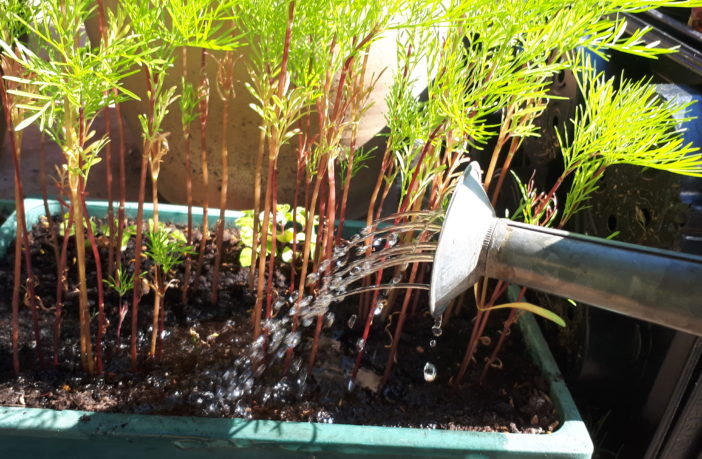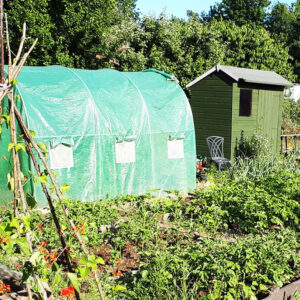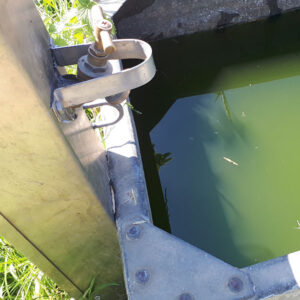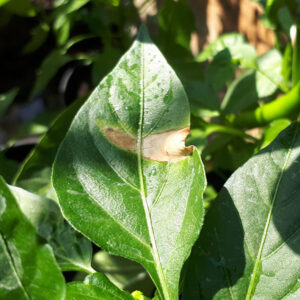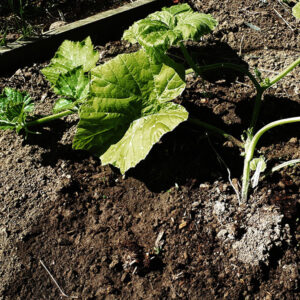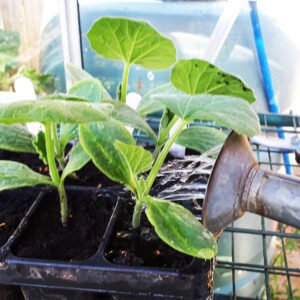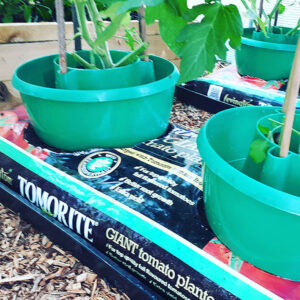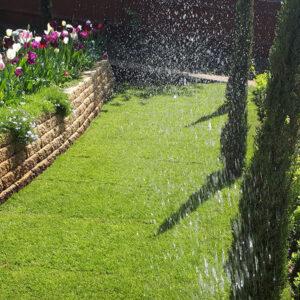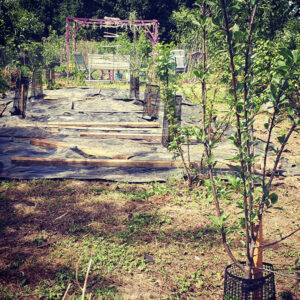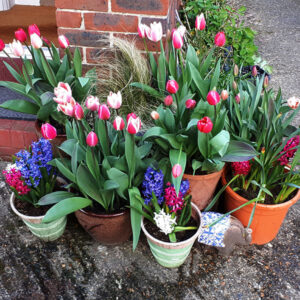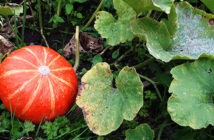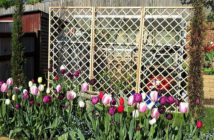I’ve been a bit short on blog writing time of late, between flower show volunteering and work (yes I DO work) I’ve been fighting the usual battle to get everything planted out in the garden and at the allotments. Having two extra overgrown half plots hasn’t helped but neither did putting a garden fork through my foot last week! Yes me, he who last year wrote an article called ‘Are you a safe gardener?‘ – it turns out that I’m not… Then there’s been the relentless watering at home and on my plots to keep things growing, blooming and fruiting (or even just alive). This climate of extremes, hotter and drier and colder and wetter really does keep us gardeners on our toes.
I love watering plants for mindfulness but I wouldn’t say no to a little bit of rain now to give me some extra time for other horticultural pursuits. We’ve had nothing more than one quick overnight shower in Dorking for six weeks! Is a hosepipe ban on the cards in 2018? I’d say yes – be prepared for that eventuality, fill up some shaded water butts and collect what little rain comes your way. I really must attach some drainpipes to my recently painted allotment shed, they’ve been sitting on the ground beside it for three years and yet I have two water butts there (used for liquid manure brewing).
Given that over 99% of all the water that plants absorb is lost to transpiration it’s a shame plants aren’t more efficient really. It’s only when you spend so much time watering them that you realise there are optimal methods of doing it. If you’re a seasoned gardener then watering knowledge probably comes second nature without you paying any mind to it, but for those new to gardening and grow your own I thought I’d highlight some watering tips to help efficiency and plant health.
Watering can or hose pipe?
Get yourself a large watering can (10 litres), a tiny watering can (for watering precious seedlings) and a hose pipe for occasional use. Whilst my garden will often be treated to a hose soaking due to it being on a steep hillside with lawn terraces, I prefer to water my allotment each day with a watering can. Yes this means multiple trips to an allotment tap and water tank but the tap is on the corner of my plot (it’s why I chose it) and this allows me to water selectively around the plants that I want to grow. If I hosed down the entire plot I would:
- Help weeds germinate and grow everywhere.
- Help fungal diseases such as blight and rust to spread.
- Help slugs and snails to mobilise and eat my crops.
I have allotment neighbours who soak their plots from top to bottom with a hose pipe but I have never really understood that approach. It probably saves a little time on watering but the other negatives I’ve highlighted above surely outweigh that time-saving?
When to water outdoor plants?
During a prolonged dry spell it is best to water your outdoor plants early in the morning or later in the evening as the sun sets. Watering in this way gives plant roots plenty of time to absorb water and nutrients before it evaporates (which happens quickly if you water during the midday sun). This doesn’t mean you can’t water at lunchtime if you see that your plants are about to expire but do this only in emergency scenarios and avoid splashing the leaves to reduce leaf scorch damage. Water on leaves in sunlight magnifies the light and burns the leaves – chillies are very susceptible. Remember that many plants will wilt during the heat of the day anyway, don’t panic unless they are still wilting in the evening.
Personally I prefer to water my plants in the morning if I can because the plants are photosynthesising during daylight when they need all available root resources. I find that at night wet soil is easier for slugs and snails to travel across for their dinner – night time soakings are an invitation to gastropods far and wide, especially in a drought.
Where to water plants?
Obviously most plants require water applied to them at their base but try not to be too restrictive with the spread. Don’t make life too easy for your plant by only watering close to the stem, they will become lazy. The further out from the plant’s main stem that you water, the more likely roots are to spread and deepen to pick up nutrients – making a stronger plant.
In the case of pumpkin and squash plants I try to avoid watering the immediate base at all once they have had a week to acclimatise to their allotment homes (I plant them out and don’t sow direct). Then of course if you start burying the vines too they will set down extra roots and need additional watering there too. Potatoes need water on both sides of any earthed up banks rather than the stem base because the roots spread and this is where the potatoes are gaining weight.
How much to water?
I love the sound of water draining down into a dried raised bed on a sunny day, but if you can hear that ‘snap crackle and pop’ noise then you probably need to water a little more often. As a rule if I water a planting bed and the water immediately disappears I water it again. I want the water to sit on the surface for about four to five seconds, longer than that and no watering is required. You certainly don’t want a puddle of water sitting around for more than a minute, roots need oxygen as well as water and can drown. One of my new allotments was covered in plastic for a few years, the soil beneath is bone dry, the squash and pumpkin plants I put in there are getting extra water each day. In terms of other crops I find runner beans particularly water dependent, they love a good soak each day and a feed of liquid nettle manure – it’s hard to over-water beans. Onions are a temperamental vegetable, don’t let them dry out or they may suddenly bolt but like garlic don’t over-water or they may rot. Chillies and peppers on the other hand do not appreciate too much water, so they get a drink in the polytunnel every three days, I also have them in a raised bed which drains quickly.
Mulch to retain water
Applying a mulch of old leaves and manure to the surface of beds is a very useful method of reducing water evaporation because the organic material provides a shield from sunlight. I find this method especially useful at home where we have sandy soil on terraces which dries out in hours. However a mulch can provide hiding places for slugs and snails – I’m pretty sure this year’s allium destruction has been down to my winter mulching. My allotments on the other hand are on heavy clay – this can be a misleading soil, often looking dusty and dry on the surface but plunge your hand in and a few centimetres down you find it’s still damp. For this reason I’d take clay over sandy soil any day of the week.
Some watering specifics:
Watering greenhouse seedlings:
I often water seedlings twice a day in the greenhouse (morning and evening) using a small watering can with a rose for gentle water pressure. You can reduce the need to water by potting seedlings on into larger pots as soon as you can. Large plants in small pots dry out very quickly. During very warm weather stand seedling pots inside a large tray of water. I actually use a plastic pond which I picked up on freecycle, it is perfect for all my pots to stand in, I simply fill it with one centimetre of water so that pots don’t dry out while I’m at work. During very hot spells you can also temporarily cover a greenhouse roof with a sheet or old net curtain to reduce temperature and evaporation but there is often no substitute for taking all the plants out in the morning and returning them at night.
Watering tomato plants:
Tomatoes are my perennial pain in the backside – they are so susceptible to pests and diseases that I often swear I’ll never grow them again. If it’s not white fly or blossom-end-rot it’s the dreaded blight. However I do seem to have found the perfect method of growing them this year inside the allotment polytunnel. The plants are in growbags, the growbags are inside large plastic grow-trays and each plant lives inside a ‘plant halo’ on the surface of the compost. I water into the halo which holds the water feeding it out and away from the stem as the day progresses. This is again good for root spread. The tray retains water to prevent the bag drying out. This method of regular drip watering combined with a regular feed of comfrey liquid manure or V4 tomato feed has produced monster plants. Finally pinching out tomato plants at 5ft tall and cutting off two levels of leaves from the bottom puts them into fruiting mode and reduces their demand for water. This is in addition to regularly removing the side-shoots.
Watering a new lawn (and paddling pools):
Newly laid turf needs watering twice a day for at least three weeks for the roots to take, thereafter you can probably water it in evenings only so that it gets a good overnight recovery. If like me you have a young family and the inevitable joy of a paddling pool you should avoid putting the pool up on new turf in the first year. Otherwise I find that a paddling pool can stay up on a lawn for three to four days without doing permanent damage to the grass. Try to buy a pool with a white bottom rather than a dark one, this allows some light to continue reaching the grass beneath. Use the water from your paddling pool for your garden and lawn watering, if swimming children wear sunscreen in the pool I probably wouldn’t use it on seedlings but grass, shrubs and large flower pots will be fine.
Watering newly planted fruit trees:
Last winter I planted ten dwarf fruit trees on my new orchard allotment plot (44B) – in their first year fruit trees need extra water as the roots establish, especially during dry spells. Typically I water each tree once a week with 10 litres of water (a full watering can), again not too close to the growing trunk but in a circle around the base. In a heatwave I double this to watering twice a week. Given than I have also now re-used some black plastic to keep the weeds down around the trees I have also reduced natural rainfall levels getting through anyway so this watering will continue regardless for a few months. As a side note never water fruit tree branches once they hold fruit as this can encourage fungal diseases to develop and spread.
Watering floral pots:
Ah floral pots, I really love pots for their ability to help me create my own arrangements outside the house and rotate them to fit the blooms as and when they appear. It’s one of the key things I’ve taken from workshops at Great Dixter, Dixter House is famous for using pots outside its entrance to create a beautiful display. However, do not underestimate how quickly pots dry out without trays – even when it is raining. Water outdoor flower pots once a week during mild and rainy spells but twice a day during very hot dry spells. You will also need to feed the soil once a week to keep the plants in full bloom. Despite your best watering efforts I do find most potted flowers last half the time of those planted out in the ground.
And fInally… watering acid loving plants like Blueberries:
Blueberries have to be watered with rainwater rather than tap water because they are acid loving plants and tap water is usually alkaline. If like me your water butt is almost empty of rainwater you may be concerned about what to use next! Whilst not ideal you can fill up a watering can with tap water before you go to bed, then the following morning, when the chlorine level has also dropped, add two tablespoons of vinegar to lower the water PH. Better still buy some Azalea feed from your local garden centre – but vinegar is good in an emergency.

